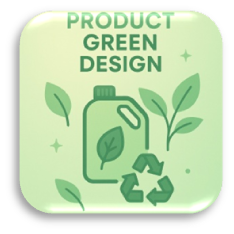policy
Compliance with laws and regulations, meeting social needs; preventing
pollution, reducing environmental impact;
continuous improvement, and sustainable environmental development.
USERJOY responds to global carbon reduction initiatives by advancing corporate
sustainability. With reference to ISO
50001 Energy Management Systems, we implement low-carbon operations, including TCFD
climate risk identification and ISO
14064-1 greenhouse gas inventories, and execute continuous improvement through our
carbon reduction pathway of
“Commitment, Inventory, Management, Reduction, Offset, and Evaluation.”
Key carbon reduction pathway strategies are summarized below:
| Strategy |
Content |
| Commitment |
Pledged to achieve net-zero emissions by 2050,
integrated into long-term ESG strategic goals. |
| Inventory |
Established a comprehensive GHG inventory mechanism
covering Scopes 1, 2, and 3, with regular data-driven management. |
| Management |
Aligned with ISO 14064-1 and ISO 50001 frameworks to
enhance monitoring efficiency and ensure emission reduction plan
implementation.
|
| Reduction |
Implement server virtualization, energy monitoring,
green transportation, and low-carbon product design to reduce energy
consumption. |
| Offset |
Procure green energy and adopt green procurement to
mitigate external emissions impact. |
| Evaluation |
Establish internal/external review mechanisms to
regularly assess ESG performance and adjust carbon reduction strategies
to meet low-carbon transition goals. |
Energy Management Measures
| Category |
Content |
| Equipment Optimization and Procurement |
Replace high-energy-consumption equipment with
high-efficiency servers, cooling systems, and lighting fixtures; install
energy-saving bulbs/tubes; purchase 3C products with national energy-saving
certification.
|
| Smart Power Monitoring |
Implement smart power monitoring systems for real-time
analysis and optimization of corporate electricity usage through
data-driven management. |
| Employee Training and Awareness |
Provide energy management education to enhance staff
energy-saving awareness, including turning off lights when not in
use and maintaining air conditioning at 26°C or higher with timers. |
| Continuous Improvement Mechanism |
Ensure standardized and consistent energy usage through
SOPs and staff training. Internal Audits: Regularly review
energy management systems for ISO 14001 compliance. Integrate ISO 50001 and
ISO 14064-1 to monitor carbon emissions via
GHG inventories and optimize energy use. Periodically evaluate energy
management strategies for sustained optimization. |
| Planned Targets |
Establish phased targets to achieve low-carbon
transition and progress toward net-zero emissions. |
Energy Conservation Targets
| Category |
Content |
| Short-term (By 2024) |
Reduce per capita electricity consumption by 1%
compared to the previous year. |
| Medium-term (By 2030) |
Reduce per capita electricity consumption by 1%
compared to the previous year. |
| Long-term (By 2050) |
Achieve corporate net-zero emissions in alignment with
global development trends. |
Energy Usage Status
Electricity Reduction Achievements: (4.93% reduction in electricity usage and GHG
emissions (tonCO₂e) in 2024 compared
to previous year)
| Year |
Electricity Consumption (kWh) |
GJ |
Emission Factor |
GHG Emissions (tonCO₂e) |
Reduction Difference |
| 2022 |
572,346 |
2060.4456 |
0.495 |
283.3113 |
- |
| 2023 |
579,068 |
2084.6448 |
0.494 |
286.0596 |
+0.9701% |
| 2024 |
573,746 |
2065.4856 |
0.474 |
271.9556 |
-4.93% |
Server Virtualization Technology Achievements: (50% reduction in physical servers in
2024, lowering energy consumption
and improving operational efficiency)
| Year |
Actual Servers |
Reduction Quantity |
Remaining Quantity |
達成率 |
| 2022 |
103 |
41 |
62 |
75.93% |
| 2023 |
62 |
10 |
52 |
18.52% |
| 2024 |
52 |
3 |
49 |
5.56% |
Water Resource Management
1. Water Resource Management
As a cultural and creative industry company, our primary water usage is for domestic
purposes, with no production
processes or wastewater discharge issues. Statistical analysis shows minimal water
consumption, indicating no
significant environmental impact. Nevertheless, we remain committed to water
conservation by implementing comprehensive
daily water-saving practices and enhancing awareness campaigns to maximize water
reduction efficiency.
2. Water Conservation Measures
(1) Installation of water-saving valves on faucets, reducing water usage by
one-third.
(2) Posting water conservation signage near all water fixtures.
(3) Regular inspection of water equipment to minimize leaks.
(4) Priority use of water-efficient fixtures in building facilities.
(5) Automated timed shutdown for chilled water systems.
3. 2024 Implementation Results: Water Usage / Targets / Achievement Status
| Year |
A=Water Usage (m³) |
B=Total Employees |
C=A/B Average Water Use (m³/person) |
Target & Achievement Status |
D=C×F/1000 Per Capita GHG Emissions (tonCO₂e) |
F=Emission Factor |
Water Management Target & Achievement Status |
| 2022 |
3528.1762 |
480 |
7.3504 |
Water carbon emissions: Annual reduction of 0.05 tonCO₂e / First
monitoring |
0.0012 |
0.161 |
Average water use: Annual reduction of 0.05 / First monitoring |
| 2023 |
3950.4140 |
495 |
7.9806 |
Water carbon emissions: Annual reduction of 0.05 tonCO₂e / Not achieved.
Company expansion, staff increased. |
0.0012 |
0.152 |
Average water use: Annual reduction of 0.05 / Not achieved. Company
expansion, staff increased. |
| 2024 |
4119.6942 |
499 |
8.2359 |
Water carbon emissions: Annual reduction of 0.05 tonCO₂e / Not achieved.
|
0.0013 |
0.156 |
Average water use: Annual reduction of 0.05 / Not achieved. Company
expansion, staff increased. |
Wastewater Discharge Compliance Record
| Wastewater Discharge Compliance Record |
| Year |
2022 |
2023 |
2024 |
| Number of Violations |
0 |
0 |
0 |
Waste Management
|
|
 |
Waste Management
As a cultural and creative industry company rather than a manufacturer,
waste management is not classified as a material
issue for our operations. Our primary waste consists of general office
waste generated from daily employee activities,
which is processed in full compliance with local government regulations.
Recognizing increasing industry expectations for environmental
strategies, we hold ourselves accountable to energy
conservation standards for water, electricity, and waste output. We
continuously educate employees on implementing
carbon reduction practices in their daily work routines.
|
 |
Product Green Design and Management
(1) Since 2008, we have adopted app downloads and virtual currency
distribution to minimize product packaging, thereby
reducing resource waste from logistics, inventory transport, printing,
and optical disc production.
(2)For certain supplementary marketing materials, established production
and disposal procedure management regulations for
product packaging, all compliant with EPA regulations. We have
formulated a Supplier Management Policy, requiring and
mandating suppliers to comply with applicable environmental laws
according to industry characteristics.
|
 |
Waste Disposal Statistics
| Disposal Quantity (Kg/year) |
2022 |
2023 |
2024 |
| Hazardous Waste |
0 |
0 |
0 |
| Non-Hazardous Waste (kg) Disposal Quantity (Kg/year) |
2022 |
2023 |
2024 |
| General Waste |
21,411.39 |
22,298.5 |
22,610.84 |
| Paper |
365.4378 |
500.1143 |
668.0212 |
| Plastics |
18.9336 |
15.1340 |
33.1016 |
| Mental Cans |
NA |
11.3344 |
11.9140 |
| Total |
21,795.7614 |
22,825.0827 |
23,323.8768 |
|